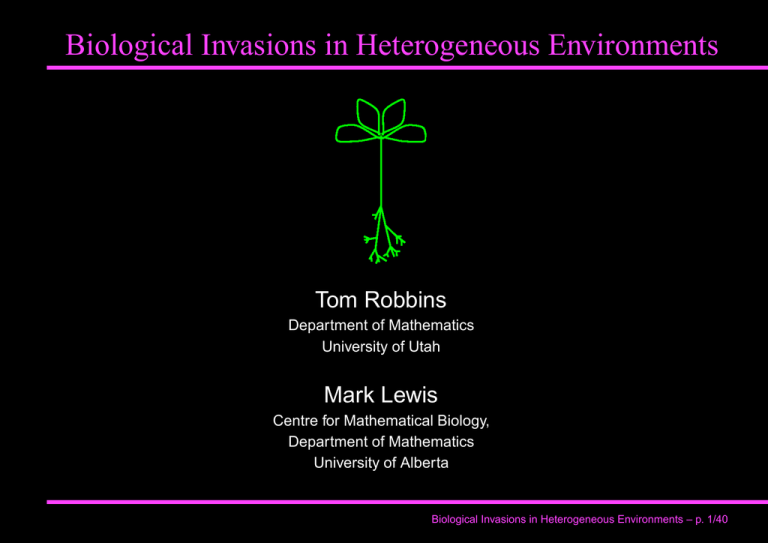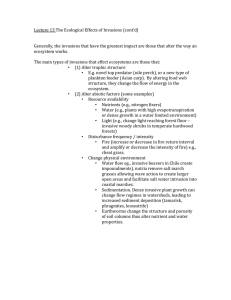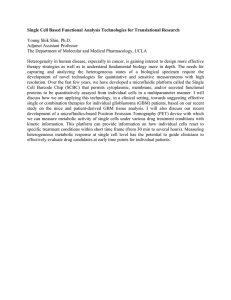Biological Invasions in Heterogeneous Environments Tom Robbins Mark Lewis
advertisement

Biological Invasions in Heterogeneous Environments
Tom Robbins
Department of Mathematics
University of Utah
Mark Lewis
Centre for Mathematical Biology,
Department of Mathematics
University of Alberta
Biological Invasions in Heterogeneous Environments – p. 1/40
Outline
1. Background on biological invasions
2. Mathematical model for plant species
3. Results for homogeneous environments
4. Results for heterogeneous environments
(a) Species persistence
(b) Spread rate
5. Dispersal on multiple spatial scales
6. Summary
Biological Invasions in Heterogeneous Environments – p. 2/40
Biological Invasions?
•
What are biological invasions?
• A biological invasion is the introduction and spread of an
exotic species within an ecosystem
• Estimated 450 million exotics imported into the US per year
[Center et al. - 1995]
•
Why are biological invasions important?
• Economic impact:
Cumulative $110 billion by 1991 to the US economy
[Williamson - 1996]
• Contribute to the loss of biodiversity
• Threat to endangered species
Biological Invasions in Heterogeneous Environments – p. 3/40
Conceptual Framework
•
Arrival and Establishment
• Most invasions fail!
• All communities are invasible
• Invasion (or propagule) pressure is important
[Biological Invasions, Williamson - 1996]
Biological Invasions in Heterogeneous Environments – p. 4/40
Conceptual Framework
•
Arrival and Establishment
• Most invasions fail!
• All communities are invasible
• Invasion (or propagule) pressure is important
•
Spread
[Biological Invasions, Williamson - 1996]
Biological Invasions in Heterogeneous Environments – p. 4/40
Conceptual Framework
•
Arrival and Establishment
• Most invasions fail!
• All communities are invasible
• Invasion (or propagule) pressure is important
•
Spread
•
Equilibrium and effects
• Most invaders have only minor consequences
• Few have disastrous consequences!
[Biological Invasions, Williamson - 1996]
Biological Invasions in Heterogeneous Environments – p. 4/40
Reaction–Diffusion Models
∂n
∂2n
= D 2 + (r0 − κn)n,
∂t
∂x
where
•
n = n(x, t) is the frequency of the mutant allele
•
D is the diffusion coefficient
•
Logistic growth, r0 is the intrinsic growth rate
•
Fisher, 1937: Spread of an advantage gene within a homogeneous population
•
Skellam, 1951
•
Aronson and Weinberger, 1975
•
Shigesada et al., 1986
Biological Invasions in Heterogeneous Environments – p. 5/40
Reaction–Diffusion Models
∂n
=D
∂t
∂2n
∂2n
+
∂x2
∂y 2
ff
+ r0 n,
where
•
n = n(x, y, t) is the population density
•
D is the diffusion coefficient
•
Malthusian growth, r0 is the intrinsic growth rate
•
Fisher, 1937
•
Skellam, 1951: Modeled the range expansion of introduced muskrats in Europe
•
Aronson and Weinberger, 1975
•
Shigesada et al., 1986
Biological Invasions in Heterogeneous Environments – p. 5/40
Reaction–Diffusion Models
∂n
∂2n
= D 2 + h(n)n,
∂t
∂x
where
•
n = n(x, 0) has compact support
•
D is the constant diffusion coefficient
•
h is the intrinsic growth rate, h(0) > 0 and ∂h/∂n ≤ 0 for all n ≥ 0
•
Fisher, 1937
•
Skellam, 1951
•
Aronson and Weinberger, 1975: ARS for population is
•
Shigesada et al., 1986
c∗
p
= 2 h(0)D
Biological Invasions in Heterogeneous Environments – p. 5/40
Reaction–Diffusion Models
∂n
∂
=
∂t
∂x
ff
∂n
D(x)
+ (r0 (x) − κn)n,
∂x
where
•
n = n(x, t) is the population density
•
D = D(x) is the spatially dependent, periodic diffusion coefficient
•
r0 = r0 (x) is the spatially dependent, periodic intrinsic growth rate
•
Fisher, 1937
•
Skellam, 1951
•
Aronson and Weinberger, 1975
•
Shigesada et al., 1986: Fisher equation with spatial heterogeneity
Species persistence and dispersion relation for a Traveling Periodic Wave (TPW)
Biological Invasions in Heterogeneous Environments – p. 5/40
Biological Problem
•
Consider the invasion of terrestrial plant species
•
Assume spatial heterogeneity for local growth and dispersal ability
•
How is invasibility and spread rates of the population affected by:
• local growth rates?
• seed deposition rates?
• the ratio of local to long-distance seed dispersal?
•
Can spread rates be increased or slowed down (possible stalled) by habitat
heterogeneity?
Biological Invasions in Heterogeneous Environments – p. 6/40
Mount St. Helens
•
Mt. St. Helens erupted on May 18, 1980
•
North of the crater, the Pumice Plain is a patchy environment,
approximately 25 km2 , with hills, valleys, craters and rivers
•
Lupinus lepidus (Lupine) appeared in 1981, south of Spirit lake
•
Lupine patches are located over much of the plain, with current estimates of over
108 plants
•
Lupine seeds are thought to be wind and water dispersed
(•)
[del Moral and Wood - 1987, 1993, 1995, Bishop]
Biological Invasions in Heterogeneous Environments – p. 7/40
Biological Model
•
Terrestrial plant species
•
Infinite, one-dimensional environment
•
Assume that growth and dispersal occur in
distinct, nonoverlapping stages
•
Plant survival is limited to one cycle,
with nonoverlapping generations
Biological Invasions in Heterogeneous Environments – p. 8/40
Mathematical Model
Integrodifference equation (IDE) model for the population density
Nτ +1 (x) =
Z
+∞
f (Nτ (y); y)k(x, y)dy
−∞
where
•
τ is the generation count
•
Nτ (x) is the seed density at the start of generation τ
•
f is the nonlinear growth function
•
k(x, y) is the dispersal kernel
Biological Invasions in Heterogeneous Environments – p. 9/40
IDE Models
•
Kot et al. - 1996:
Spread of D. pseudoobscura, estimating the kernel from data
•
Van Kirk and Lewis - 1997, Lutscher and Lewis - 2003:
Species persistence in fragmented habitats
•
Clark - 1998:
Model tree migration in response to climate change
•
Neubert and Caswell - 2000, Neubert and Parker - 2004:
Model the spread of invasive plant species
Biological Invasions in Heterogeneous Environments – p. 10/40
Growth Function
Nτ + 1 (x) = f (Nτ (x); x)
2
•
Nτ (x) is the seed density at the start of generation τ ,
Nτ + 1 (x) is the seed density at the end of generation τ , before dispersal
2
•
f is continuous, monotone increasing and bounded above
•
The maximum per capita reproductive ratio, r0 , occurs at arbitrarily
low population densities, is positive and bounded away from 0
Biological Invasions in Heterogeneous Environments – p. 11/40
Growth Function: Example
•
Example for a homogeneous environment: Beverton-Holt stock-recruitment curve
f (N ) =
r0 N
1 + [(r0 − 1)N ]
r0 = 2
Biological Invasions in Heterogeneous Environments – p. 12/40
Dispersal Kernel
•
k(x, y) is a pdf for a seed released from a location y and
being deposited at a location x, i.e., for some y,
Z +∞
k(x, y)dx = 1
−∞
•
The IDE is the sum of all seeds dispersed to x, i.e., for some x,
Z
+∞
−∞
Nτ + 1 (y)k(x, y)dy < ∞
2
Biological Invasions in Heterogeneous Environments – p. 13/40
Model for Seed Dispersal
•
The dispersal model:
(1)
(2)
∂u
∂t
∂v
∂t
u(x, 0; y)
v(x, 0; y)
=
∂2u
D 2 − au
∂x
=
au
=
δ(x − y)
=
0
• u is the airborne seed density
• v is the seed density on the ground
• a is the deposition rate
• k(x, y) = lim v(x, t; y)
t→∞
[Neubert et al. - 1995]
Biological Invasions in Heterogeneous Environments – p. 14/40
Laplace Dispersal Kernel
•
Let a(x) ≡ a
•
Integrate (2) from t = 0 to ∞:
Z
∞
0
∂d
dt
∂t
=
=
=
˛∞
˛
d(x, t; y) ˛
t=0
k(x, y)
Z ∞
cdt
a
0
•
Integrate (1) from t = 0 to ∞:
Z
0
∞
∂c
dt
∂t
=
=
=
=
˛∞
˛
c(x, t; y) ˛
t=0
−δ(x − y)
Z ∞ 2 ff
Z ∞
∂ c
D
cdt
dt − a
2
∂x
0
0
ff
Z
Z
∞
∞
∂2
D 2
cdt − a
cdt
∂x
0
0
Biological Invasions in Heterogeneous Environments – p. 15/40
Laplace Dispersal Kernel
•
k is the Greens function for
∂2
D 2
∂x
•
1
k(x, y)
a
ff
− k(x, y) = −δ(x − y)
The dispersal kernel is given by the Laplace distribution
k(x − y) =
r
r
ff
a
a
exp −
|x − y|
4D
D
[Broadbent and Kendall - 1953, Neubert et al. - 1995]
Biological Invasions in Heterogeneous Environments – p. 16/40
Homogeneous Environment
•
Infinite flow, one-dimensional homogeneous environment
•
Growth function of the form
f (N ; y) = f (N )
•
The dispersal kernel is translation invariant, i.e.,
k(x, y) = k(x − y)
•
The IDE model reduces to the convolution integral
Nτ +1 (x) =
Z
+∞
f (Nτ (y))k(x − y)dy
−∞
Biological Invasions in Heterogeneous Environments – p. 17/40
Traveling Wave Solution
For the initial population density
N0 (x) = δ(x)
with the Laplace dispersal kernel and Beverton-Holt growth dynamics (r0 > 1)
the solution of the IDE approaches a traveling wave:
r0 = 6, D = 1 and a = 10
Biological Invasions in Heterogeneous Environments – p. 18/40
Traveling Wave Solution
For the initial population density
N0 (x) = δ(x)
with the Laplace dispersal kernel and Beverton-Holt growth dynamics (r0 > 1)
the solution of the IDE approaches a traveling wave:
r0 = 6, D = 1 and a = 10
Biological Invasions in Heterogeneous Environments – p. 18/40
Traveling Wave Solution
For the initial population density
N0 (x) = δ(x)
with the Laplace dispersal kernel and Beverton-Holt growth dynamics (r0 > 1)
the solution of the IDE approaches a traveling wave:
r0 = 6, D = 1 and a = 10
Biological Invasions in Heterogeneous Environments – p. 18/40
Traveling Wave Solution
For the initial population density
N0 (x) = δ(x)
with the Laplace dispersal kernel and Beverton-Holt growth dynamics (r0 > 1)
the solution of the IDE approaches a traveling wave:
r0 = 6, D = 1 and a = 10
Biological Invasions in Heterogeneous Environments – p. 18/40
Traveling Wave Solution
For the initial population density
N0 (x) = δ(x)
with the Laplace dispersal kernel and Beverton-Holt growth dynamics (r0 > 1)
the solution of the IDE approaches a traveling wave:
r0 = 6, D = 1 and a = 10
Biological Invasions in Heterogeneous Environments – p. 18/40
Traveling Wave Result
•
Homogeneous, one-dimensional environment
•
N0 (x) has compact support
•
f is monotonic, bounded above and no Allee effect
•
The dispersal kernel has a moment generating function
U (s) =
Z
+∞
k(x) exp{xs}dx
−∞
•
The asymptotic rate of spread is given by
1
∗
ln (r0 U (s))
c = min
0<s
s
[Weinberger - 1982]
Biological Invasions in Heterogeneous Environments – p. 19/40
Dispersion Relation
•
A traveling wave, with positive wave speed c, is of the form
Nτ +1 (x) = Nτ (x − c)
•
Near the front, population densities are low, so the IDE can be approximated by
Nτ (x − c) = r0
Z
+∞
k(x − y)Nτ (y)dy
−∞
where r0 = f ′ (0)
•
TW ansatz: near the leading edge of the wave
Nτ (x) ∝ e−sx
for s > 0
Biological Invasions in Heterogeneous Environments – p. 20/40
Dispersion Relation
•
From this assumption
e
−sx sc
e
= r0
Z
+∞
k(x − y)e−sy dy
−∞
•
Make the change of variables u ≡ x − y
•
We have the characteristic equation
e
•
sc
= r0
Z
+∞
k(u)esu du
−∞
Solving for c as a function of s
1
c(s) = ln (r0 U (s))
s
[Kot et al. - 1996]
Biological Invasions in Heterogeneous Environments – p. 21/40
Dispersion Relation: Laplace Kernel
•
The moment generating function:
a
U (s) =
D
•
»
1
a/D − s2
–
For the Laplace dispersal kernel, the dispersion relation is:
»
–ff
a
1
1
c(s) = ln r0
s
D a/D − s2
Biological Invasions in Heterogeneous Environments – p. 22/40
Homogeneous Environment: Application?
•
UL: Exponentially bounded kernel
•
UR: Fat-tailed kernel
•
LL: Dispersal kernels
•
LR: Location of wave front
Biological Invasions in Heterogeneous Environments – p. 23/40
Heterogeneous Environment
•
Growth function of the form f = f (N ; x), e.g.,
f (N ; y) =
•
•
r0 (x)N
1 + [(r0 (x) − 1)N ]
The dispersal model:
∂c
∂t
∂d
∂t
c(x, 0; y)
d(x, 0; y)
=
∂2c
D 2 − a(x)c
∂x
=
a(x)c
=
δ(x − y)
=
0
The IDE model is of the form
Nτ +1 (x) = ANτ =
Z
+∞
f (Nτ (y); y)k(x, y)dy
−∞
Biological Invasions in Heterogeneous Environments – p. 24/40
Periodic Heterogeneity
•
Periodically divide the environment into good (r0 > 1) and bad (r0 < 1) patches:
8
< r
if 0 ≤ x < xa
1
r0 (x) =
: r2 if xa ≤ x < l
r0 (x + l)
•
=
r0 (x)
Divide the environment into high (a = 1) and low (a < 1) deposition patches:
8
< a
if 0 ≤ x < xa
1
a(x) =
: a2 if xa ≤ x < l
a(x + l)
=
a(x)
[Shigesada et al. - 1986, Weinberger - 2002]
Biological Invasions in Heterogeneous Environments – p. 25/40
Dispersal Kernel
•
k(x, y) for the homogeneous environment and heterogeneous environment:
D = 1, a1 = 1, a2 = 0.4, l = 1, xh = 0.4
Biological Invasions in Heterogeneous Environments – p. 26/40
Colony Persistence
•
A colony is said to persist in an environment if when initially introduced at low
densities, the population density eventually increases
Biological Invasions in Heterogeneous Environments – p. 27/40
Colony Persistence
•
A colony is said to persist in an environment if when initially introduced at low
densities, the population density eventually increases
•
Consider when N ∗ ≡ 0 is unstable, where
N ∗ = AN ∗ ,
i.e., for all ξ0 (x) such that kξ0 k < ǫ, does kAτ ξ0 k → 0?
Biological Invasions in Heterogeneous Environments – p. 27/40
Colony Persistence
•
A colony is said to persist in an environment if when initially introduced at low
densities, the population density eventually increases
•
Consider when N ∗ ≡ 0 is unstable, where
N ∗ = AN ∗ ,
i.e., for all ξ0 (x) such that kξ0 k < ǫ, does kAτ ξ0 k → 0?
•
This is equivalent to studying the spectrum of the linearization of A near N ∗
Biological Invasions in Heterogeneous Environments – p. 27/40
Colony Persistence
•
A colony is said to persist in an environment if when initially introduced at low
densities, the population density eventually increases
•
Consider when N ∗ ≡ 0 is unstable, where
N ∗ = AN ∗ ,
i.e., for all ξ0 (x) such that kξ0 k < ǫ, does kAτ ξ0 k → 0?
•
This is equivalent to studying the spectrum of the linearization of A near N ∗
•
For the linear IDE, we analyze the eigenvalue problem
Biological Invasions in Heterogeneous Environments – p. 27/40
Colony Persistence
•
A colony is said to persist in an environment if when initially introduced at low
densities, the population density eventually increases
•
Consider when N ∗ ≡ 0 is unstable, where
N ∗ = AN ∗ ,
i.e., for all ξ0 (x) such that kξ0 k < ǫ, does kAτ ξ0 k → 0?
•
This is equivalent to studying the spectrum of the linearization of A near N ∗
•
For the linear IDE, we analyze the eigenvalue problem
•
N ∗ is stable if λ1 < 1 and unstable if λ1 > 1, where λ1 is the dominant eigenvalue
Biological Invasions in Heterogeneous Environments – p. 27/40
Colony Persistence
•
The eigenvalue problem is
λ1 φ1 (x) =
Z
+∞
r0 (y)φ1 (y)k(x, y)dy
−∞
•
Recall the linear operator L, where
∂2
Lk =
∂x2
k(x, y)
a(x)
•
Apply L to the eigenvalue problem
•
Hill’s equation:
d2
dx2
φ1 (x)
a(x)
ff
ff
− k(x, y) = −δ(x − y)
+ a(x) [µ1 r0 (x) − 1]
φ1 (x)
a(x)
ff
=0
where µ1 = 1/λ1
[Van Kirk and Lewis - 1997]
Biological Invasions in Heterogeneous Environments – p. 28/40
Colony Persistence
The resulting condition for λ1 = 1 is:
0 = F (a2 , r1 , r2 , xa , l)
p
:= 1 − cos xa [r1 − 1] ×
p
cos (l − xa ) a2 [r2 − 1]
[r1 − 1] + a2 [r2 − 1]
p
+ p
×
2 [r1 − 1] a2 [r2 − 1]
p
sin xa [r1 − 1] ×
p
sin (l − xa ) a2 [r2 − 1]
Biological Invasions in Heterogeneous Environments – p. 29/40
Colony Persistence: Example
•
high deposition in good patches
•
Deposition rate in bad patch (a2 ) vs. relative fraction of good patches (xa ):
fixed growth rate in the good patch (r1 )
a1 = 1, l = 1, r2 = 0.5
•
Stable region is below the curve
Biological Invasions in Heterogeneous Environments – p. 30/40
Traveling Periodic Wave
•
N0 (x) has compact support
•
N ∗ ≡ 0 is unstable
•
Nτ (x)/a(x) for τ large
0.8
N (x)/a(x)
nsτ
Nτ(x)/a(x)
0.6
0.4
τ = 70
τ = 75
0.2
0.0
0
10
20
30
x
40
50
60
70
a2 = 0.4, R1 = 1.2, R2 = 0.5, l = 1
[Shigesada et al. - 1986, Weinberger - 2002]
Biological Invasions in Heterogeneous Environments – p. 31/40
Traveling Periodic Wave
•
Consider the IDE model
Nτ +1 (x) =
+∞
Z
k(x, y)f (Nt (y); y)dy
−∞
•
Assume the existence of a traveling periodic wave (TPW)
N̂ (x − c) =
Z
+∞
k(x, y)f (N̂ (y); y)dy
−∞
•
Traveling wave ansatz:
Near the leading edge of the TPW
N̂ (x) ∝ e−s(x−cτ ) g(x),
where g(x + l) = g(x)
•
Near the leading edge of the TPW
N̂ (x) ≪ 1
Biological Invasions in Heterogeneous Environments – p. 32/40
Traveling Periodic Wave
•
Consider the linearized IDE
Nτ (x) =
Z
+∞
r0 (y)Nτ (y)k(x, y)dy
−∞
•
From the traveling wave ansatz
e
sc
` −sx
´
e
g(x)
Z +∞
=
r0 (y)e−sy g(y)k(x, y)dy
−∞
•
Apply the linear operator L
•
Hill’s equation:
ˆ −sc
˜
d2 ϕ
+
a(x)
e
r
(x)
−
1
ϕ=0
0
dx2
where ϕ(x) = e−sx g(x)/a(x)
Biological Invasions in Heterogeneous Environments – p. 33/40
Dispersion Relation for the TPW
Assume a traveling periodic wave and derive the dispersion relation:
0 = G(s, c ; a2 , r1 , r2 , xa , l)
p
:= cosh(sl) − cos xa [r1 e−sc − 1] ×
p
cos (l − xa ) a2 [r2 e−sc − 1]
[r1 e−sc − 1] + a2 [r2 e−sc − 1]
p
+ p
×
2 [r1 e−sc − 1] a2 [r2 e−sc − 1]
p
sin xa [r1 e−sc − 1] ×
p
sin (l − xa ) a2 [r2 e−sc − 1]
Biological Invasions in Heterogeneous Environments – p. 34/40
Dispersion Relation: Example
•
high deposition in good patches, low deposition in bad patches
•
Dispersion relation for TPW:
fixed fraction of good patches (xa )
a2 = 0.4, r1 = 1.2, r2 = 0.5, l = 1
Biological Invasions in Heterogeneous Environments – p. 35/40
Multiple Dispersal Scale Model
•
The dispersal model:
∂u1
∂t
∂v1
∂t
u1 (x, 0; y)
v1 (x, 0; y)
=
∂ 2 u1
Dη
− a(x)u1
∂x2
=
a(x)u1
=
δ(x − y)
∂u2
∂t
∂v2
∂t
u2 (x, 0; y)
=
0
v2 (x, 0; y)
•
Dη ≪ D
•
Define the dispersal ratio
8
< w
1
w(x) =
: w2
•
=
∂ 2 u2
D
− a(x)u2
∂x2
=
a(x)u2
=
δ(x − y)
=
0
if 0 ≤ x < xa
if xa ≤ x < l ;
w(x + l) = w(x)
ff
Let k(x − y) = lim w(y)v1 (x, t; y) + (1 − w(y))v2 (x, t; y)
t→∞
Biological Invasions in Heterogeneous Environments – p. 36/40
Multiple Dispersal Scale Model
•
The IDE model is
Nτ +1 (x) =
Z
+
Z
+∞
f (Nτ (y); y)k1 (x, y; Dǫ )dy
−∞
+∞
f (Nτ (y); y)k2 (x, y; D)dy
−∞
•
How does local dispersal affect invasibility?
•
How does local dispersal affect the spread rate?
Biological Invasions in Heterogeneous Environments – p. 37/40
Invasion Model: Colony Persistence
•
0 ≤ w(x) ≤ 1 and high deposition in good patches
•
Deposition rate in bad patch (a2 ) vs. relative fraction of good patches (xa )
a1 = 1.0, r1 = 1.2, r2 = 0.5, l = 1
•
Local dispersal increases species persistence
Biological Invasions in Heterogeneous Environments – p. 38/40
Invasion Model: Traveling Periodic Wave
•
0 ≤ w(x) ≤ 1 and high deposition in good patches
•
Dispersion relation for the speed of the wave:
a2 = 0.4, r1 = 1.2, r2 = 0.5, w2 = 0, l = 1
•
Local dispersal can slow the invasion
Biological Invasions in Heterogeneous Environments – p. 39/40
Summary
•
Use of the periodicity assumption to derive conditions for species persistence
•
Dispersion relation for the traveling periodic wave without explicit knowledge
of the dispersal kernel
•
Invasibility:
• Bad patches decrease invasibility
• Local dispersal increases invasibility
•
Spread rate:
• Bad patches decrease spread rates
• Local dispersal decreases spread rates
Biological Invasions in Heterogeneous Environments – p. 40/40






